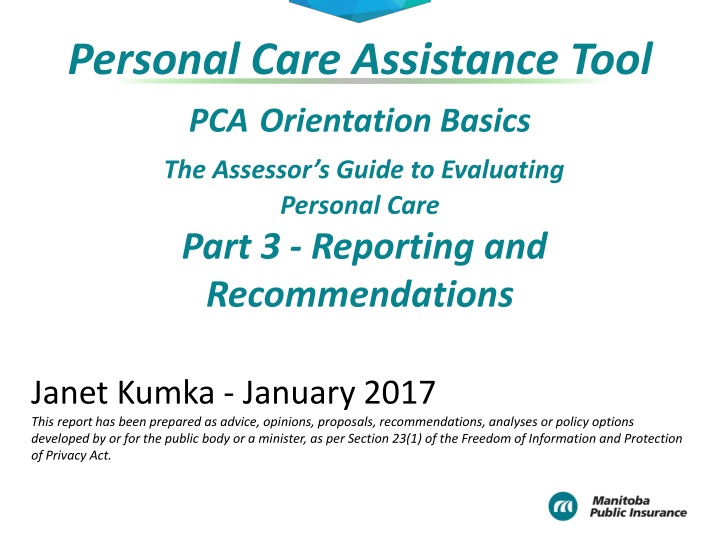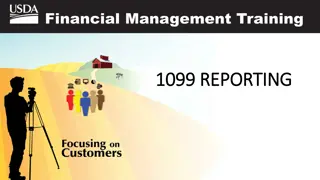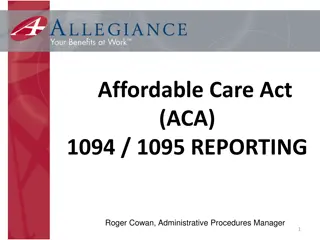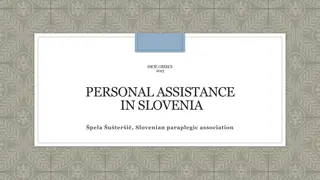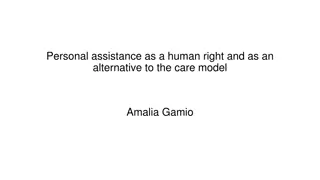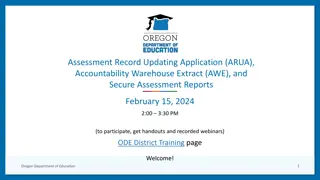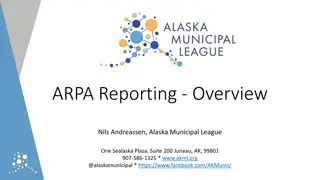Comprehensive Guide to Reporting in Personal Care Assistance Assessment
The report outlines the importance of accurate reporting in Personal Care Assistance (PCA) assessments, emphasizing compliance with regulations and the need for current information. It provides guidance on submitting PCA reports, ensuring accuracy in claimant details, and avoiding misleading information. The document highlights the significance of using quantifiable measures, such as Range of Motion (ROM) and Manual Muscle Testing (MMT), to establish baselines and evaluate care needs effectively.
Uploaded on Sep 16, 2024 | 0 Views
Download Presentation

Please find below an Image/Link to download the presentation.
The content on the website is provided AS IS for your information and personal use only. It may not be sold, licensed, or shared on other websites without obtaining consent from the author.If you encounter any issues during the download, it is possible that the publisher has removed the file from their server.
You are allowed to download the files provided on this website for personal or commercial use, subject to the condition that they are used lawfully. All files are the property of their respective owners.
The content on the website is provided AS IS for your information and personal use only. It may not be sold, licensed, or shared on other websites without obtaining consent from the author.
E N D
Presentation Transcript
Personal Care Assistance Tool PCA Orientation Basics The Assessor s Guide to Evaluating Personal Care Part 3 - Reporting and Recommendations Janet Kumka - January 2017 This report has been prepared as advice, opinions, proposals, recommendations, analyses or policy options developed by or for the public body or a minister, as per Section 23(1) of the Freedom of Information and Protection of Privacy Act.
Part 3 - Overview Submission of PCA reports Reporting Recommendations for assistive devices 2
Submission of PCA reports In order to comply with PHIPPA and PHIA regulations, it is required that all PCA reports are to be submitted via the designated Manitoba Public Insurance PCA website: If you are required to make an amendment to a previously submitted report, do not revise and re- submit the previous report, but rather complete a PCA amendment and specify the report date for which this applies and submit your narrative document in Word to the above link. https://apps.mpi.mb.ca/pca/pca.aspx 3
Reporting Ensure the claimant name, claim number and assessment date is accurate. Ensure all reporting is current; remove stale dated information from previous reports as this can be viewed as misleading. If the claimant is requesting consideration of retrospective care needs prior to the assessment date, this must be reviewed and approved by the case manager prior to the submission of the report.
Reporting Avoid comments on assistance that is required within the recommendation section of the report, as this reflects that you are providing a score which may differ from the determined score. Avoid summary comments such as needs assistance with all personal care activities as this is often not the case and can mislead the claimant. 5
Reporting Use quantifiable measures in your reporting, and refrain from generalized statements of limited or reduced ROM unless followed by objective measures. Provide Range Of Motion (ROM), Manual Muscle Testing (MMT) or balance measures to establish a baseline, then review for consistency or change from objective findings from previous reporting and comment on same.
Reporting Maintain consistency between what you have reported within the narrative section as compared to the functional report within levels 1 & 2 of the report. Report inconsistencies between diagnosis, subjective complaints and observed function. Make the call - provide your opinion as to whether the claimant would be independent with pacing or task modification and or equipment in place.
Reporting If an activity is deemed as N/A then do not provide comments that assistance is required within the subcategories as this only leads to ambiguity which requires further clarification prior to finalizing the score. When you determine that the claimant had third party services in-place prior to the MVC (i.e., Home Care ) you need to specify in detail what services were being provided, the frequency and for what tasks in relation to what physical or cognitive limitation. Note: if an increase in care is required you need to specify that it is related to what MVC related injury and or limitation. 8
Reporting If changes in function or a decline are evident upon re-assessment that were not identified on previous assessment /s or have not been linked to a specific cause related to the MVC (i.e., surgery). Indicate what the change is, be specific, and comment as to whether this change is new and whether it had an impact on the claimant s function that was not previously identified as a barrier. Seek clarification from the case manager before finalizing your report. Causation may be under review.
PCA Report Sample 1 Meals Preparations: She is able to peel vegetables. She is able to chop and demonstrated she holds knife in right (dominant) hand and has to push down on the blade with the left hand. Need for assistance is related to the right shoulder injury that occurred after the MVC and determined as unrelated to the MVC. Clean-up: She is able to wipe counters with left hand. She demonstrated she is able to wash dishes in the sink but has to lean forward to compensate for the reduced ROM in her right shoulder (related to a post MVC fall and subsequent shoulder injury). In this case, the claimant is considered as Independent with meal tasks with respect to MVC related injuries. 10
PCA Report Sample 2 Vacuuming: Subj- Claimant reported he does not vacuum at home due to his ongoing symptoms. We discussed his participation in the work hardening program and he reported he attended 4 hrs per day x 5 days a week. He stated he was able to pace himself, work through his symptoms (i.e., headaches) and took a break when needed. Obj- Functional testing at the end of Sept 2012 put him in the Medium strength range. The writer notes vacuuming is within the Light strength demand, therefore based on objective testing he should be able vacuum as far as strength is concerned. Ax- ct was able to retrieve the central vac from the hall closet and set it up. He vacuumed the entire back hallway using his left hand. It took him 3 minutes, 15 seconds. At the end, he reported low back pain, an increase in pelvic discomfort, and that he felt "a little dizzy". His NPRS increased from 3/10 at the start to 5-6/10 by the end of the task. 11
PCA Report Sample 2 cont He was able to demonstrate carrying the central vacuum hose up and down the basement stairs without too much difficulty, and he was able to return the vacuum to the hall closet when he was finished Rx- Based on demonstrated function, it is the assessor s opinion that Mr. Smith is able to vacuum. It was recommended that he pace himself (take breaks as needed, do different sections of the house throughout the week, etc.) in order to manage his symptoms. This is a good detailed example of a functional assessment where the assessor provided an objective opinion based on claimant demonstrated function. 12
Recommendations It can be assumed that the case manager will approve the recommendation and provision of assistive devices (on invoices totaling under $100.00 per claim) that will facilitate independence with a specific task/s. In cases of the following, formal written approval is required: Adaptation of a motor vehicle Structural alteration of the victim s residence Provision of powered mobility aids Provision of communication, learning and cognitive therapy aids 13
Recommendations Once implemented, the claimant s score will reflect the level of independence with the use of the assistive device in place. If at the time of assessment, the claimant refuses an assistive device that would facilitate independence with that activity, this must be specified and the claimant will be scored according to it s use regardless of choice. 14
Reassessments In general, re-assessments will be completed at intervals in accordance with the type and severity of the claimant s injury and as directed by MPI. Assessors should recommend when a re-assessment should be conducted based on the claimant s injury type and any other factors that may affect a claimant s recovery or continued entitlement to PCA. MPI is responsible for confirming the re-assessment of a claimant. 15
Part 3 - Summary Submission of PCA reports Reporting Recommendations for assistive devices 16
